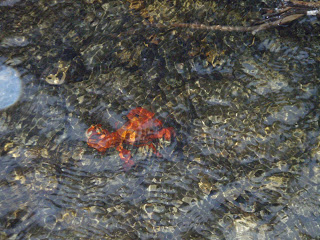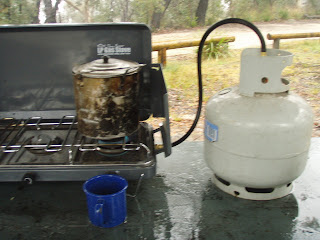 Yellow Tufted Honey Eater.
Yellow Tufted Honey Eater.This weekends walk is perhaps the most spectacular of all the walks in the Blue Mountains. It would take me along the nature trail and into the Valley of the Waters. It commenced in West Street, Wentworth Falls, passed Edinburgh Castle rock and along the cliffs. What is different about this walk is- most walks in the Blue Mountains are either on top of the cliffs or, down into the valleys. This walk places you in between with some of the trail cut into the side of the cliff. This give the walker incredible views and aspects. From intimate water falls to views across the Jammison Valley.
 New steel walkways across swamp areas
New steel walkways across swamp areasSpectacular waterfalls, rain forests and distant views are part of the package. What surprises me though, is the number of walkers ill prepared. YOU MUST ALWAYS CARRY WATER and a FIRST AID KIT. There were a number of tourists and walkers asking me how much further to go, looking stressed and uncertain because, whilst not difficult, you must be fit. Seven km does not sound far until you are finding yourself climbing ladders and stairs that seem to go on "for ever". The best way to enjoy a walk like this is to plan, take plenty of fluid (you cannot drink from the streams as one fellow was), take lots of snacks and rest when you feel the need. Getting too focused on the walk and placing each foot in front of the other can ruin what even Charles Darwin walked and commented on. Places such as Lodard Falls and Vera Falls are truly spectacular and an ideal place for lunch or a swim ( weather permitting).
 Some of the cliff faces I would walk along.
Some of the cliff faces I would walk along.Its important to note- that there are 2 trails in this area, one that even the inexperienced ( though well equipped) can enjoy, and the other that which the national parks suggests more experienced walkers only try. All tracks are clearly sign posted.
On this walk I spotted Lewins Honey Eater, Regent Honey Eater, New Holland Honey Eater, and Grey Shrike Thrush. I was very pleased to identify one I had not seen before-Yellow Tufted Honey Eater. A striking bird with very yellow markings and a distinct black eye mask. Yellow Rumped Thorn Bill were always a welcome sight too.
 Vera Falls
Vera FallsAfter lunch I chose to return the way I came- all up hill. After a few hours walking I had returned to the car- the only evidence of the walk- a HUGE blood blister on my big toe. I did not notice this until the following day!
Walking in the Blue Mountains is fun and beautiful but cannot stress just how important it is to be prepared- carry plenty of water, know your limitations, and plan. Frankly there were just too many people asking my advise and looking stressed. If the day was hotter, some may have been in serious trouble.
Birds seen:- Australian Magpie, Pee Wee, grey Butcher Bird, Currawong, Bell Minor, Masked Lapwing, Lewins Honey Eater, New Holland Honey Eater, Regent Honey Eater, Yellow Tufted Honey Eater, Rosella, Yellow Rumped Thornbill, Grey Shrike Thrush, Satin Bower Bird.


















